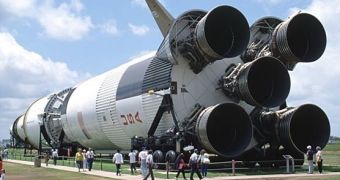More than half of a century has passed since the first U.S. artificial satellite was lifted into space, inaugurating a long series of space launches. However, while most of the technology used to build the launch vehicles progressed at an extremely high rate, the design of the trusty rocket engine remained mostly unchanged. Don't expect anything spectacular in the future either, Clark Hawk director of the Propulsion Researche Center at the University of Alabama says that not much will change, not even in the design of the rockets which will carry the next missions to the Moon.
The reason for this is relatively easy to guess. Rocket engines are the only type of engine design capable of producing enough thrust to propel a spacecraft upwards, in order to escape Earth's powerful gravitational field. The rocket engine can provide massive amounts of power for a couple of minutes, just enough to put something in space in a safe and cheap way.
The rocket engines for the launch of the mission, that will take the next manned spacecraft to the surface of the moon, are actually direct descendants from the J-2 engines used by the Saturn launch vehicle, back in the 1960. One might think that they would at least give it a radically new name or something, however U.S. engineers chose the conservative way and named it J-2X.
Clark argues that even though the principle of the rocket engines didn't evolve a great deal over the years, the engineers today still have a massive advantage over the first developers of such devices, respectively more than five decades of experience into rocket design and advances into materials and hardware, which will be incorporated into the J-2X.
Moreover, the UAHuntsville facility is able to offer NASA engines with high safety standards and performance. For example, in order to do so, the research center must have the capability of running tests which used liquid oxygen and methane at the same time. The facility also benefits from the presence of a combustion stability research tool. There are only three such tools available in the world, and that owned by the U.S. is located at the UAHuntsville facility.
The combustion stability tool gives the engineers the capability of evaluating the injector element of the rocket, to meet the specifications presented by NASA. On the other hand, the facility is also studying the different aspect of improvement into chemical propulsion technologies that may provide a solution for future propulsion designs. One of those future propulsion designs is the plasma propulsion device that uses power sources other than those resulted directly from a chemical reaction. Plasma thrusters are extremely efficient propulsion systems, but they only produce small amounts of thrust, thus they can only be used in space applications.
Further studies into the field of advanced devices would ultimately provide a better understanding in the physics associated with the next level of propulsion systems, for which the UAHuntsville facility provided a foundation.

 14 DAY TRIAL //
14 DAY TRIAL //